-
 Bitcoin
Bitcoin $108,489.6704
1.13% -
 Ethereum
Ethereum $2,502.0528
2.92% -
 Tether USDt
Tether USDt $1.0002
0.00% -
 XRP
XRP $2.1941
0.51% -
 BNB
BNB $655.3375
1.00% -
 Solana
Solana $151.5977
1.27% -
 USDC
USDC $0.9999
0.00% -
 TRON
TRON $0.2768
0.32% -
 Dogecoin
Dogecoin $0.1676
2.86% -
 Cardano
Cardano $0.5675
0.98% -
 Hyperliquid
Hyperliquid $40.6109
7.48% -
 Bitcoin Cash
Bitcoin Cash $500.7746
2.09% -
 Sui
Sui $2.8328
2.03% -
 Chainlink
Chainlink $13.4452
1.26% -
 UNUS SED LEO
UNUS SED LEO $9.1623
0.39% -
 Avalanche
Avalanche $18.2267
2.24% -
 Stellar
Stellar $0.2382
0.00% -
 Toncoin
Toncoin $2.8885
1.68% -
 Shiba Inu
Shiba Inu $0.0...01159
0.91% -
 Litecoin
Litecoin $87.1827
0.88% -
 Hedera
Hedera $0.1511
2.90% -
 Monero
Monero $315.4992
-0.59% -
 Polkadot
Polkadot $3.4663
2.34% -
 Bitget Token
Bitget Token $4.6118
-0.65% -
 Dai
Dai $1.0000
-0.01% -
 Ethena USDe
Ethena USDe $1.0003
0.02% -
 Uniswap
Uniswap $7.2989
4.69% -
 Pepe
Pepe $0.0...01003
5.73% -
 Aave
Aave $275.5616
7.15% -
 Pi
Pi $0.5181
-2.49%
Is the short-term selling point when the upper rail of the Bollinger band encounters resistance and falls back?
When price touches the upper Bollinger Band, it signals strength, but traders should wait for bearish confirmation like candlestick reversals or RSI divergence before considering a short-term sell.
Jun 30, 2025 at 03:29 pm
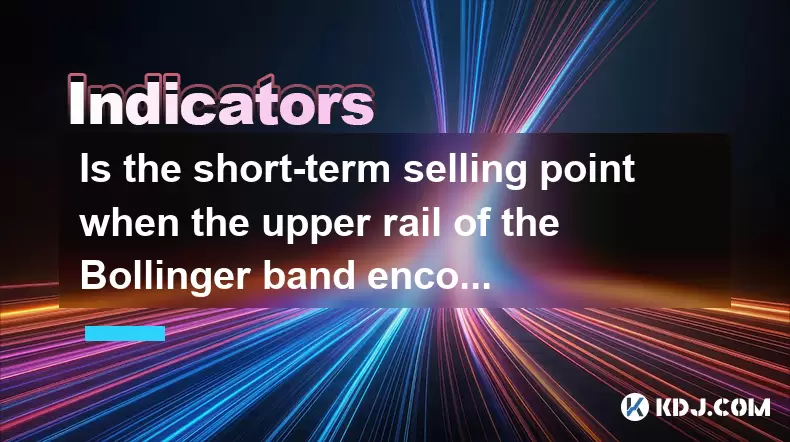
Understanding Bollinger Bands and Their Role in Trading
Bollinger Bands are one of the most widely used technical indicators in cryptocurrency trading. They consist of three lines: a simple moving average (SMA) in the middle, typically set to 20 periods, and two outer bands that are standard deviations away from the SMA—usually set at 2 standard deviations. These bands dynamically adjust based on price volatility.
In the context of crypto markets, where prices can swing dramatically within short timeframes, Bollinger Bands help traders identify potential overbought or oversold conditions. When price touches or moves outside the upper band, it is often interpreted as a sign of strength. However, this doesn't automatically mean a reversal is imminent—it simply indicates that the asset is trading at a relatively high level compared to its recent average.
What Happens When Price Hits the Upper Band?
When price touches or briefly exceeds the upper Bollinger Band, many traders interpret this as a signal that the asset may be overextended to the upside. This often leads to speculation about a potential pullback or reversal, especially if there's no strong fundamental news driving the move.
However, in trending markets, particularly during bullish phases, price can ride along the upper band for extended periods without reversing. Therefore, encountering resistance at the upper band does not guarantee an immediate sell-off. It must be analyzed in conjunction with other factors such as volume, candlestick patterns, and support/resistance levels.
Is Resistance at the Upper Band a Reliable Short-Term Sell Signal?
Many novice traders believe that any rejection from the upper Bollinger Band is a sell signal, but this is not always the case. In fact, using the Bollinger Band alone to make trade decisions can lead to premature entries and false signals.
- A rejection at the upper band should be confirmed by bearish candlestick formations, such as shooting stars, hanging men, or engulfing candles.
- Additionally, volume should contract or show signs of exhaustion after a rally to suggest that buyers are losing control.
- If price closes below the middle SMA, it could indicate a shift in momentum and a possible retracement.
It's crucial to understand that a touch of the upper band isn’t inherently bearish unless followed by clear signs of weakness.
How to Combine Bollinger Bands with Other Indicators for Better Accuracy
To increase the probability of a successful short-term trade when price encounters resistance at the upper band, consider combining Bollinger Bands with complementary tools:
- Relative Strength Index (RSI): An RSI reading above 70 may confirm overbought conditions, supporting the idea of a pullback.
- MACD: A bearish crossover or divergence in the Moving Average Convergence Divergence (MACD) indicator can add weight to the sell signal.
- Volume Analysis: A sharp drop in volume following a rally suggests weakening demand and potential reversal.
- Fibonacci Retracement Levels: Identifying key Fibonacci levels can help determine whether the current move is part of a larger trend or just a countertrend bounce.
By integrating these tools, traders can filter out false signals and improve the timing of their short-term trades.
Practical Steps to Execute a Short-Term Trade Based on Upper Band Rejection
If you're considering entering a short-term trade upon observing resistance at the upper Bollinger Band, follow these steps carefully:
- Monitor the price action closely near the upper band to look for bearish candlestick reversals.
- Wait for a confirmation candle close below the upper band, indicating that selling pressure has taken over.
- Check if any of the accompanying indicators like RSI or MACD align with the bearish scenario.
- Set your entry point slightly below the rejection candle’s low to avoid false breakouts.
- Place a stop-loss order above the recent swing high to manage risk effectively.
- Determine your profit target based on previous support levels or by measuring the height of the move leading into the rejection.
Remember, even with all these filters, no strategy guarantees success, so proper risk management is essential.
Common Pitfalls to Avoid When Using Bollinger Bands for Shorting
One of the biggest mistakes traders make is treating Bollinger Bands as standalone tools. Here are some common pitfalls to avoid:
- Assuming every upper band touch is a sell signal without confirming with price action or volume.
- Ignoring the broader market context, such as ongoing uptrends or major news events that could sustain the rally.
- Failing to use stop-loss orders, which can lead to significant losses if the price continues upward instead of reversing.
- Entering trades too early before confirmation, only to see the price continue in the opposite direction.
Avoiding these mistakes requires discipline and a structured approach to analyzing each setup.
Frequently Asked Questions
Q: Can I rely solely on Bollinger Bands for making sell decisions?
No, Bollinger Bands should not be used in isolation. Combining them with candlestick analysis, volume data, and other technical indicators will improve accuracy and reduce false signals.
Q: What if the price stays above the upper Bollinger Band for a long time?
This is often a sign of a strong uptrend. The bands expand with increasing volatility, and in trending markets, price can remain elevated. Traders should focus on trend continuation strategies rather than expecting immediate reversals.
Q: How do I know if the rejection at the upper band is genuine or a fakeout?
Look for confirmation through candlestick patterns and volume. If the price quickly moves back inside the bands after touching the upper rail and forms a bearish pattern, it's more likely a valid rejection.
Q: Should I short immediately when the price hits the upper band?
No, it's better to wait for confirmation. Enter the trade only after seeing a bearish candle close below the upper band and ideally with supporting signals from other indicators like RSI or MACD.
Disclaimer:info@kdj.com
The information provided is not trading advice. kdj.com does not assume any responsibility for any investments made based on the information provided in this article. Cryptocurrencies are highly volatile and it is highly recommended that you invest with caution after thorough research!
If you believe that the content used on this website infringes your copyright, please contact us immediately (info@kdj.com) and we will delete it promptly.
- Rekt, Ovie Faruq, and the Movement: How a Crypto Meme Became a Consumer Brand
- 2025-06-30 21:10:14
- BlockDAG, Crypto Loyalty, and the XRP Slide: What's the Buzz?
- 2025-06-30 21:10:14
- Cryptos to Invest in Now: Spotting the Future Giants
- 2025-06-30 20:50:12
- PENGU's Upside Rally: Decoding the Stock Potential
- 2025-06-30 21:15:12
- Arbitrum, Robinhood, and Pullback Risk: Decoding the Latest Buzz
- 2025-06-30 21:20:12
- Chainlink Price Prediction: Will LINK Hit $13 Peak or Face Correction?
- 2025-06-30 21:25:11
Related knowledge
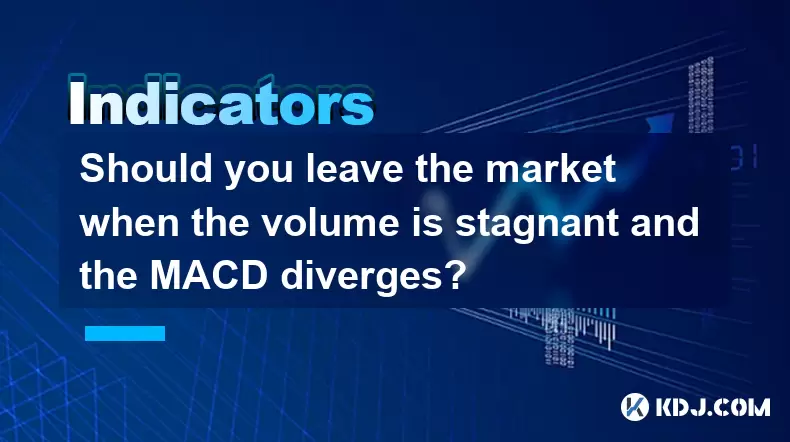
Should you leave the market when the volume is stagnant and the MACD diverges?
Jun 30,2025 at 09:36pm
Understanding Volume Stagnation in Cryptocurrency TradingIn the realm of cryptocurrency trading, volume plays a crucial role in determining the strength of price movements. When volume remains stagnant over an extended period, it suggests that neither buyers nor sellers are showing strong conviction. This often leads to sideways movement or consolidatio...
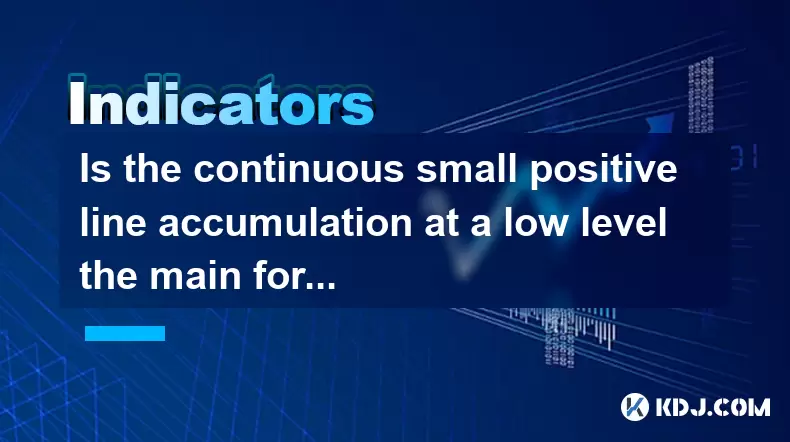
Is the continuous small positive line accumulation at a low level the main force to build a position?
Jun 30,2025 at 08:15pm
Understanding the Concept of Continuous Small Positive Line AccumulationIn cryptocurrency trading, continuous small positive line accumulation refers to a pattern where an asset experiences multiple consecutive candlesticks or bars that close higher than they open, but with relatively low volume and minimal price movement. This phenomenon is often obser...
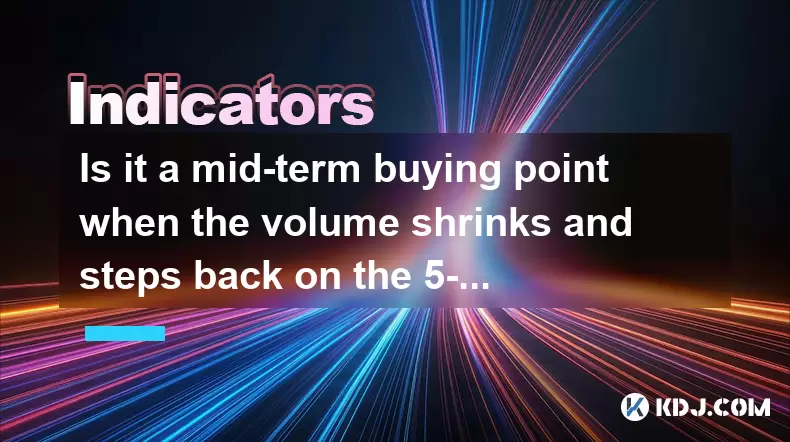
Is it a mid-term buying point when the volume shrinks and steps back on the 5-week line in the upward trend?
Jun 30,2025 at 07:49pm
Understanding the 5-Week Moving Average in Cryptocurrency TradingIn cryptocurrency trading, technical indicators such as the 5-week moving average are widely used to assess long-term trends. This indicator smooths out price volatility over a five-week period and provides traders with a clearer picture of the direction in which an asset is moving. When a...
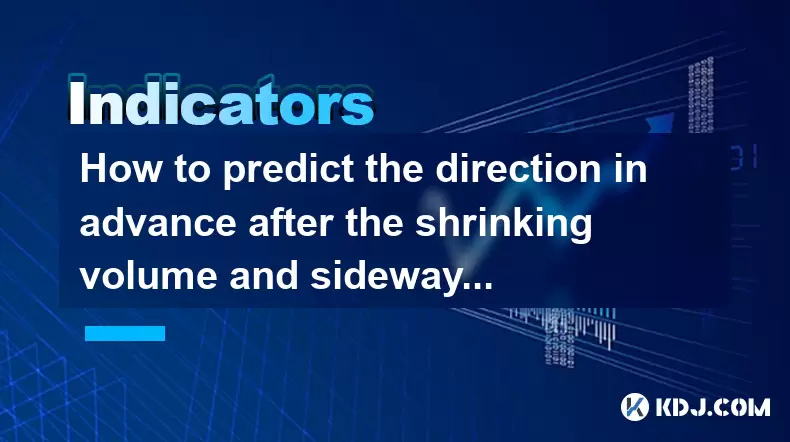
How to predict the direction in advance after the shrinking volume and sideways shock?
Jun 30,2025 at 08:57pm
Understanding Shrinking Volume and Sideways ShockIn the cryptocurrency market, shrinking volume refers to a period where trading activity significantly decreases. This often indicates a lack of interest or uncertainty among traders regarding the next price movement. Simultaneously, sideways shock occurs when the price moves within a narrow range without...
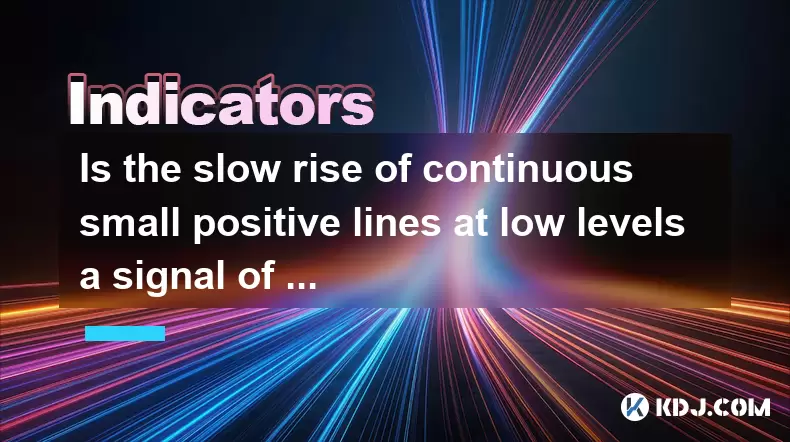
Is the slow rise of continuous small positive lines at low levels a signal of the main force absorbing funds?
Jun 30,2025 at 07:00pm
Understanding the Concept of Continuous Small Positive Lines in CryptocurrencyIn the realm of cryptocurrency trading, price patterns are often analyzed to predict future movements. One such pattern is the slow rise of continuous small positive lines at low levels, which refers to a situation where an asset’s price gradually increases over time through a...
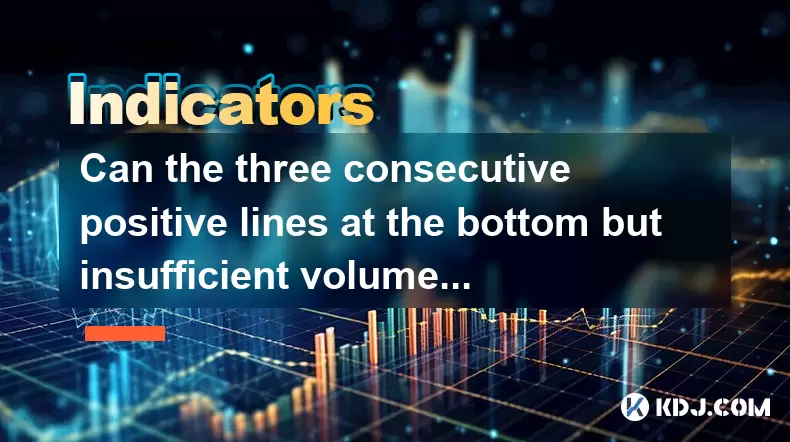
Can the three consecutive positive lines at the bottom but insufficient volume confirm the trend reversal?
Jun 30,2025 at 09:28pm
Understanding the Context of Three Consecutive Positive CandlesIn technical analysis, observing three consecutive positive lines (candles) at the bottom of a downtrend can raise questions about a potential trend reversal. These candles typically indicate that buyers have started to exert pressure after a prolonged decline. However, merely seeing these b...

Should you leave the market when the volume is stagnant and the MACD diverges?
Jun 30,2025 at 09:36pm
Understanding Volume Stagnation in Cryptocurrency TradingIn the realm of cryptocurrency trading, volume plays a crucial role in determining the strength of price movements. When volume remains stagnant over an extended period, it suggests that neither buyers nor sellers are showing strong conviction. This often leads to sideways movement or consolidatio...

Is the continuous small positive line accumulation at a low level the main force to build a position?
Jun 30,2025 at 08:15pm
Understanding the Concept of Continuous Small Positive Line AccumulationIn cryptocurrency trading, continuous small positive line accumulation refers to a pattern where an asset experiences multiple consecutive candlesticks or bars that close higher than they open, but with relatively low volume and minimal price movement. This phenomenon is often obser...

Is it a mid-term buying point when the volume shrinks and steps back on the 5-week line in the upward trend?
Jun 30,2025 at 07:49pm
Understanding the 5-Week Moving Average in Cryptocurrency TradingIn cryptocurrency trading, technical indicators such as the 5-week moving average are widely used to assess long-term trends. This indicator smooths out price volatility over a five-week period and provides traders with a clearer picture of the direction in which an asset is moving. When a...

How to predict the direction in advance after the shrinking volume and sideways shock?
Jun 30,2025 at 08:57pm
Understanding Shrinking Volume and Sideways ShockIn the cryptocurrency market, shrinking volume refers to a period where trading activity significantly decreases. This often indicates a lack of interest or uncertainty among traders regarding the next price movement. Simultaneously, sideways shock occurs when the price moves within a narrow range without...

Is the slow rise of continuous small positive lines at low levels a signal of the main force absorbing funds?
Jun 30,2025 at 07:00pm
Understanding the Concept of Continuous Small Positive Lines in CryptocurrencyIn the realm of cryptocurrency trading, price patterns are often analyzed to predict future movements. One such pattern is the slow rise of continuous small positive lines at low levels, which refers to a situation where an asset’s price gradually increases over time through a...

Can the three consecutive positive lines at the bottom but insufficient volume confirm the trend reversal?
Jun 30,2025 at 09:28pm
Understanding the Context of Three Consecutive Positive CandlesIn technical analysis, observing three consecutive positive lines (candles) at the bottom of a downtrend can raise questions about a potential trend reversal. These candles typically indicate that buyers have started to exert pressure after a prolonged decline. However, merely seeing these b...
See all articles

























































































